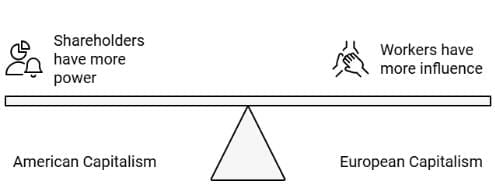July 1 – Essay: 2026 | UPSC Daily Answer Writing Practice PDF Download
Where Does Capitalism Go From Here ?
Structure
1. Introduction- The fall of communism and the rise of market economics.
2. Body
- The victory of capitalism.
- Liberal capitalism has little to celebrate.
- Examples from America, Germany, and Japan.
- All forms of capitalism share certain fundamentals.
- The economy under communism.
- China has implemented some capitalist reforms but maintains significant state control, in contrast to India ’s economic policies.
- Capitalism is proficient at conducting experiments.
- Rapid progress in East Asia.
- Revolution in communication.
3. Conclusion
- The spread of capitalism in the world’s poorest regions.
- Technology serves as the strongest counterbalancing force.
Model Essay
The future of capitalism appears uncertain, especially with the command economy still presenting itself as a viable alternative. There are ongoing debates about whether different models of capitalism—such as American, European, and East Asian—will converge into something more uniform or continue to remain distinct. Additionally, there is a pressing question of whether Western capitalism can adapt and survive the emerging challenges of the coming decades. In the American model, shareholders play a dominant role in running companies, while workers have less influence due to the decline of labour unions. European capitalism, on the other hand, limits the power of shareholders and gives workers more authority in decision-making processes. For example, in Germany, workers' unions are given seats on supervisory boards, and banks hold significant sway in corporate governance. In Japan, capitalism takes a different route where managers are given considerable freedom to run companies in a way that balances the interests of employees, partner firms, and shareholders.
In the American model, shareholders play a dominant role in running companies, while workers have less influence due to the decline of labour unions. European capitalism, on the other hand, limits the power of shareholders and gives workers more authority in decision-making processes. For example, in Germany, workers' unions are given seats on supervisory boards, and banks hold significant sway in corporate governance. In Japan, capitalism takes a different route where managers are given considerable freedom to run companies in a way that balances the interests of employees, partner firms, and shareholders.
Despite such differences, fundamental features of capitalism must be preserved for it to succeed. One key principle is the separation of politics and economics. In capitalist economies, decisions about the production, pricing, and distribution of goods and services are made in markets, where buyers and sellers interact voluntarily. Governments may participate as buyers, sellers, or regulators but rarely impose complete control over prices. For instance, when hiring civil servants, governments offer market wages to attract suitable candidates. The extent of government intervention in capitalism is usually a political decision, while the way it intervenes remains an economic consideration.
In contrast, systems like communism or feudalism intertwine politics and economics, allowing those in power to control resources through non-market means. Such systems leave minimal space for voluntary economic transactions, except in cases of illegal exchanges. A defining characteristic of capitalism is private ownership, which often reflects the separation between politics and economics. However, ownership alone does not guarantee control; rather, it is decision-making power that ensures this separation.
The example of southern China and India in the 1980s highlights how the separation of politics and economics shapes capitalism. Despite state ownership in southern China, managers and farmers were given increasing autonomy to run operations, leading to a more market-driven allocation of resources. In contrast, India, despite having private ownership, operated under the restrictive 'licence raj' system, where factories had to seek government approval for even minor operational changes. This created a system where politics and economics remained intertwined, stifling efficiency and progress.
Regardless of their institutional differences, capitalist economies share some common characteristics. One such trait is decentralized decision-making in the allocation of resources. Markets function through spontaneous coordination, often described as the ‘invisible hand’, where competition extends beyond current producers to include potential new producers and alternative methods of production. This dynamic competition is a key driver of economic progress.
The real strength of capitalism lies in its ability to allow small-scale experiments with minimal resources. If these experiments succeed, they bring significant rewards, encouraging innovation and progress. Profits act as signals for others to adopt successful methods, while failures can be quickly abandoned without major losses. This trial-and-error process has been one of the key reasons for the relentless growth of Western capitalism over time.
However, the rapid economic growth in East Asia has brought new challenges. The increasing liberalization of markets in these regions has put pressure on trade relations with the United States and the European Community. For instance, the U.S. faces a bilateral trade deficit with China, which has led to debates over imposing tariffs and concerns about China's human rights record. Similarly, the U.S. free-trade agreement with Mexico has faced criticism for its impact on domestic manufacturers. In Europe, there is hesitation to open markets to the reforming countries of Eastern Europe. These developments reflect a broader concern that capitalism's expansion in poorer regions could weaken support for market economies in the more developed West.
 Amidst these challenges, technology, particularly in communications, has emerged as a powerful counterforce. Technological advances have lowered production costs, enabling smaller firms to compete with larger ones. At the same time, technology has created new products and expanded competitive opportunities. The communications industry itself is an excellent example of this trend, and similar changes are expected across other sectors as technology continues to evolve.
Amidst these challenges, technology, particularly in communications, has emerged as a powerful counterforce. Technological advances have lowered production costs, enabling smaller firms to compete with larger ones. At the same time, technology has created new products and expanded competitive opportunities. The communications industry itself is an excellent example of this trend, and similar changes are expected across other sectors as technology continues to evolve.
Governments are responding to these shifts by collaborating on international regulations, such as the Basel capital standards for banks and the harmonization of economic rules within the European Community. However, the pace of technological progress often outstrips governments' ability to adapt. As governments face these opposing forces, they must make a choice. One option is to give in to popular pressures that weaken the market system, such as introducing trade protectionism, supporting declining industries, expanding the welfare state, or imposing restrictions on cross-border regulatory avoidance. While these steps may seem politically convenient, they risk slowing down growth and stifling innovation.
The alternative is to continue the pro-market reforms that began in the 1990s. This approach requires advocating for free trade, supporting workers displaced by economic changes rather than trying to preserve obsolete jobs, and designing a welfare state that truly prioritizes the underprivileged over the middle class. Although this path may be politically difficult, particularly in countries where capitalism is criticized despite its contributions, it remains the most sustainable route for growth and progress.
In conclusion, while capitalism faces uncertainties—from rising competition to technological disruption—it remains a system with unparalleled strengths. Its decentralized nature, capacity for experimentation, and drive for innovation make it adaptable to changing circumstances. The challenge for governments and societies lies in preserving its core principles while navigating its flaws. By encouraging pro-growth policies and ensuring a fair and dynamic system, capitalism can continue to evolve and address the challenges of the future.
FAQs on July 1 – Essay: 2026 - UPSC Daily Answer Writing Practice
| 1. What are the main characteristics of capitalism and how do they influence economic growth? |  |
| 2. How has capitalism evolved over time, and what major milestones have shaped its development? |  |
| 3. What challenges does capitalism face in the modern world? |  |
| 4. How do different economic systems compare to capitalism in terms of benefits and drawbacks? |  |
| 5. What role do government regulations play in a capitalist economy? |  |















